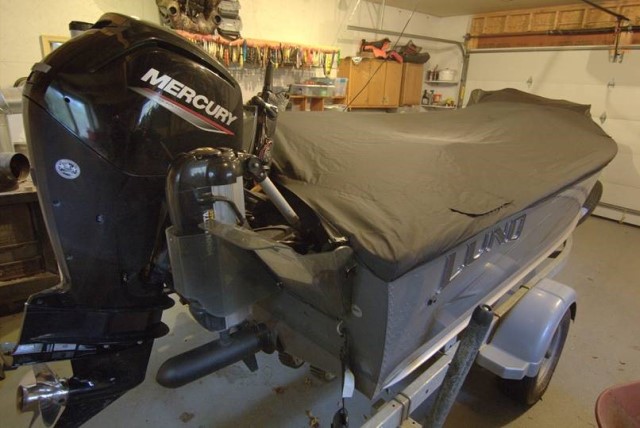Mercury Marine: How to Store Your Boat for Winter
Hibernation 101
Mercury Marine knows a lot about not just engines but a wide range of boat-related topics. Just check out their tips on how to store your boat for winter and you’ll see what we mean.

Most boats spend the offseason in dry storage on land. While there are several elements to preparing a boat for dry storage, the primary job is to eliminate water from the boat’s systems and keep water from getting in during the ensuing months. Water can add excessive weight to your rig, saturate and ruin fabrics and foams, and cause freeze-damage, which is the greatest risk of all.
To prevent any issues, you’ll need to accomplish three basic tasks, in addition to finding a safe place to store the boat:
1. Fully drain all systems in the boat that might hold water, including the engine and propulsion system, tanks and plumbing, and the hull itself.
2. Take measures to prevent water intrusion over the winter months, and to ensure that any water that gets in can freely drain out.
3. Remove and stow delicate parts of the boat, such as seat cushions, fabrics and other soft goods.
Also, it’s important to winterize the engine before storage. Mercury Marine® has several helpful resources for winterization, including the article How to Winterize Your Outboard. The process for a sterndrive or inboard engine is similar, but engines and drive units each have their own requirements, so check your owner’s manual to get the full scoop. Or you can schedule winterization service with an Authorized Mercury Dealer.
Once the engine is winterized, heed the following advice to make sure the rest of the boat is ready to go come spring.
Drain the Boat’s Systems
It’s important that the boat is dry when it’s first put away and that it stays that way all winter. Start by draining off every system. Tilt outboards into the full down position so water can drain out. Next, drain all water tanks, including freshwater and sanitation systems. Then pull the boat’s drain plug(s), and make sure the bow is slightly elevated so no water pools up inside.
With the major components now dry, run raw water accessories that have pumps (such as livewells and washdowns) until all the water is out of the system. If you still hear gurgling as the pump runs, that means the system didn’t drain completely on its own. Try blowing the lines out with compressed air, or add environmentally safe propylene glycol antifreeze. To add antifreeze, remove the intake hose from the seacock, submerge the end in a bucket full of the antifreeze and run the pump. You might need to elevate the end of the hose and pour antifreeze in to prime the pump.
If the boat has freshwater plumbing, open all the faucets or outlets with the pump running and wait until they go dry. Then close them back up, shut the pump off and add propylene glycol antifreeze to the water tank. Next, open the faucet farthest from the tank, turn the pump back on and let it run until antifreeze comes out of the faucet. Close it, go to the next-farthest outlet and do the same. Repeat the process until antifreeze is running through all the pipes and faucets and your boat’s plumbing systems are fully protected.
One tank you don’t want to drain is the fuel tank, since condensation can form in the empty tank and introduce water into the fuel supply. However, untreated fuel can cause issues when left to sit all winter. Treating the fuel is usually one of the steps of the engine winterization process, but it’s worth repeating here that, after your final fill-up of the season, the fuel tank should be treated with Mercury Quickstor® Fuel Stabilizer. Add the appropriate amount based on the instructions on the bottle, then run the engine(s) long enough for the treated fuel to make its way through the entire system. About 10 to 15 minutes should do the trick.
Prevent Water Intrusion
The best way to stop water from getting into the boat over the winter is to keep the boat covered. A garage is the ideal storage option, but if you don’t have space available, you could have a pro shrink wrap the boat for outdoor storage. Shrink-wrapping fees usually range from $15 to $25 per foot of boat, depending on the prevailing rates in your area, but that’s a worthwhile investment. Shrink wrap completely seals out the elements. Just be sure to have an optional zipper door installed if you think you might want to get inside the boat for any reason during the winter, because otherwise you’ll be just as locked out as the rain and snow. You can also use a canvas cover if it’s properly supported and can take the weight of snow and ice.
It’s also important to ensure that there’s proper ventilation to prevent condensation from building up inside the boat, which can lead to mold and mildew issues. A shrink wrap installer will add vents for you. Many boat covers have vents built in at the supports, but not all of them. If your cover doesn’t have vents already incorporated, you can purchase vents and add them yourself.
One final note: Inexpensive poly tarps should be avoided for covering boats. They rarely last for more than a couple of seasons, tend to rip or sag if they become covered with weighty snow and can wear away a boat’s gel coat or an outboard’s shiny finish if they whip-saw in the wind.
Remove Soft Goods
If you have a safe, dry place like a garage or basement where you can stow the boat’s cushions, canvas and curtains, pull them off and bring them indoors. Keeping them in a humidity-controlled environment will help prevent mold and mildew, extend their useable life and keep them from developing musty odors. If your boat has clear canvas curtains, remember to roll them up rather than folding them so creases don’t develop over the winter.
Although it certainly isn’t a soft good, another item you might want to remove is the boat’s battery or batteries. Put them on a trickle charger in a well-ventilated garage or basement throughout the winter so they’ll be in prime condition when spring arrives.
After taking all these items off the boat, if you live in an area where rodents could be problematic, consider adding mothballs or heavily scented dryer sheets to a few of the compartments, especially areas where a rodent could get access. The smells they give off will help deter mice and other critters from setting up house inside of your boat.
Boat Storage Options
If you don’t have access to a garage, a driveway large enough to store a boat or a lift where the boat can spend the winter, you can store your boat in a dedicated storage yard, often found at a local marina or dealership. Fees for winter boat storage vary quite a bit nationally, but they’re usually minimal at outdoor facilities ($20 to $50 per foot). Indoor facilities are a lot more expensive ($50 to $200 per foot is the range), but indoor storage eliminates the need to cover the boat. Commercial facilities usually have some level of security and insurance, but you’ll want to inquire about those details.
For a boat without a trailer, many marinas can haul and block the boat for winter storage. The cost depends on the size of the boat and can range from a few hundred dollars for a small runabout to thousands of dollars for large vessels. And that’s on top of the regular winter storage charges. Also, remember that you’ll have to pay again in the spring to have the boat put back in the water.
Some full-service marinas offer complete winter packages that include hauling, blocking, winterizing and shrink wrapping the boat. Again, costs vary quite a bit depending on your location, but as a general rule expect to pay from slightly less than $1,000 to several thousand dollars to get a complete package. Going this route does have another advantage, however, in that you don’t take the risk of personally making a mistake that results in damage.
Wherever you choose to store the boat, it’s always a sad day when your pride and joy gets put away for the winter. But there’s good news, too. Spring will roll around before you know it. And when you pull off that cover, reactivate the boat’s systems and fire up the engine for your first shakedown cruise – and all your boat’s systems function perfectly – it will be literally impossible to wipe that merry grin off your face.
COMPANY DETAILS |

|
|
Company |
Mercury Marine |
|
Website |
|
|
Connect |
   
|
|
Contact |
ABOUT Mercury Marine®
Mercury Marine has been making world-class outboards and sterndrives for more than 75 years. They started back in 1939 in a small machine shop in Wisconsin, and they’ve grown into the largest builder of marine propulsion systems in the world. Number one on the water. And we didn’t get there by sitting still.
